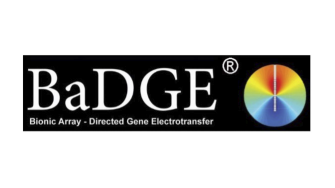
UNSW Sydney BaDGE® platform is a novel proprietary technology that enables precision delivery of DNA / RNA therapeutics using an innovative pulsed electric lensing technology. BaDGE® was developed by the team in the Translational Neuroscience Facility in the School of Biomedical Sciences and the School of Biomedical Engineering (SBmE), supported by the Tyree Institute of Health Engineering, a new joint initiative of the Faculty of Engineering and the Faculty of Medicine & Health.
The Challenge
Gene therapy is challenged by the need for targeted delivery of the DNA / RNA therapeutic molecules. The current gene delivery platforms (viral vectors, liposome-based encapsulation and open-field ‘electroporation’) have limited control of dispersion and gene dosing. DNA / RNA molecule size limitations, and safety (tissue damage and immune reactivity) are also challenging.
The solution
The UNSW BaDGE® platform was developed using bionics technology to create localised shaped electric fields in tissue to achieve targeted delivery of DNA and RNA. This technology has the major advantages of instantaneous transfer of the highly charged naked DNA and RNA molecules within target tissue volumes, alongside precise control of gene transfer dispersion and gene dose. BaDGE® was validated in pre-clinical models of nervous system repair, commencing with gene electrotransfer of DNA encoding factors to regenerate the auditory nerve. Proof of concept studies continue to expand the potential applications for BaDGE®, including use for delivery of DNA and RNA as vaccines, and for gene augmentation therapies for brain neuroprotection.
The impact
BaDGE® is enabling a first-in-human clinical trial for delivery of plasmid DNA encoding neurotrophins during cochlear implant surgery, driving directed regeneration of the auditory nerve fibres to ‘close the neural gap’ with the ‘Bionic Ear’ interface (www.cingt.info). This is a ‘bench-to-bedside’ collaboration led by the BaDGE® development group at UNSW Sydney, with research and clinical team members at the Macquarie University Hearing Hub, The University of Sydney (Otolarynology), The Royal Prince Alfred Hospital, NextSense, The Bionics Institute (University of Melbourne) and industry partner Cochlear Ltd.
The potential of the BaDGE® targeted gene delivery platform to support gene therapy applications is building strong collaborative research programs with industry and external academic partners in the area of focal brain disorders, notably gene therapy to treat epilepsy, nerve reinnervation, ophthalmic treatments, vaccines and solid tumors. The platform provides an innovative capability for targeted delivery of RNA, complementing the NSW state-backed establishment of the UNSW RNA Institute.
Key people and partners
- Prof. Gary Housley (UNSW Translational Neuroscience Facility, School of Biomedical Sciences)
- Prof. Nigel Lovell (UNSW Tyree Institute for Health Engineering & GSBmE)
- Dr. Jeremy Pinyon (University of Sydney; UNSW Adj.)
- Dr. Georg von Jonquieres (School of Biomedical Sciences, UNSW)
- Dr. Amr Al Abed (GSBmE)
- Drs. Dax Kukulj, Samantha Fung, Joy Francisco (UNSW Knowledge Exchange)
- Clinical Prof. Catherine Birman (U. Sydney, Otolaryngology, NextSense)
- Prof. Catherine McMahon, Prof. David McAlpine (Macquarie University Hearing Hub)
- Dr. Fadwa Alnafjan (Macquarie University, UNSW Adj.)
- Ms. Mayryl Duxbury (School of Biomedical Sciences, UNSW)
- Mr. Edward Crawford (School of Biomedical Sciences, UNSW Adj.)
- Mr. Stephen Mow (GSBmE)
- Dr. Waikong Lai (NextSense)
- Ms. Rachelle Hassarati (NextSense)
- Profs. Robert Shepherd, James Fallon, Andrew Wise (Bionics Inst., U. Melbourne)
- Netherlands Cancer Institute
- Hertie Inst. Clinical Brain Research, Tübingen University (Germany)
- Cochlear Ltd
- Touchlight Genetics (United Kingdom)
- Boehringer Ingelheim (Germany)
- CNRS (France)
- IDE Group
